Family name: Commelinaceae Mirbel
Synonym(s): Cartonemataceae Pichon, nom. cons.; Tradescantiaceae Salisb.
Common name(s): spiderwort family
*Number of genera/species: 41/731
List of genera records in GRIN-Global
fruit or seed
Fruit a loculicidalloculicidal:
type of capsular dehiscence, opening longitudinally through the locules (compare septicidal)
 capsulecapsule:
capsulecapsule:
a dry, dehiscent fruit derived from a compound ovary , rarely berryberry:
, rarely berryberry:
an indehiscent, fleshy fruit with one or a few to many seeds. The flesh may be homogenous throughout. Or, if the outer part is hard, firm, or leathery, referred to as an hesperidium. Septa are present in some, and the seeds may be arillate or with a fleshy testa.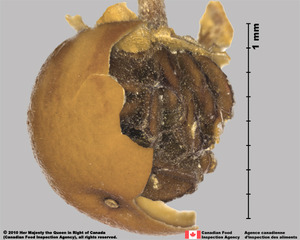 or berrylike capsulecapsule:
or berrylike capsulecapsule:
a dry, dehiscent fruit derived from a compound ovary (Pollia), sometimes winged, 1.5–15 mm long, globoseglobose:
(Pollia), sometimes winged, 1.5–15 mm long, globoseglobose:
3D shape—more or less spherical to trigonoustrigonous:
to trigonoustrigonous:
3D shape—having three faces that meet at distinct angles; triangular in outline
, angledangular:
2D shape—having sides that meet at acute or obtuse angles
in transection, sometimes beakedbeak:
a usually firm, terminal appendage, sometimes tapered , with few to many seeds. Perianthperianth:
, with few to many seeds. Perianthperianth:
collective term for calyx and corolla of a flower
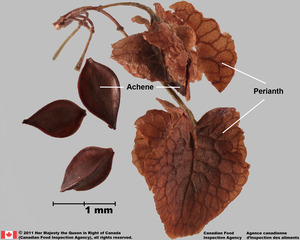 may be persistent. Pericarppericarp:
may be persistent. Pericarppericarp:
fruit wall or fruit coat
brown, gray, black, or white, sometimes blue, shinyshiny:
uniformly reflecting a high proportion of incident light at all angles or dulldull:
or dulldull:
reflecting only a low proportion of incident light, with no apparent sheen , crustaceouscrustaceous:
, crustaceouscrustaceous:
texture—thin, dry, indurate, and brittle
, leatheryleathery:
texture—moderately thick, tough, and very pliable
, membranousmembranous:
texture—extremely thin, pliable, and fairly tough
, glabrousglabrous:
without hairs
or pubescent, smooth, spinyspiny:
having slender, stiff, sharp projections oriented in the general plane of the structure , wartywarty:
, wartywarty:
surface relief—distinct, rounded projections that are large relative to the fruit size; tuberculate, verrucose , reticulatereticulate:
, reticulatereticulate:
surface relief—netted, raised walls or concave grooves forming a net-like surface pattern with flat, concave, or convex interspaces , or wrinkledwrinkled:
, or wrinkledwrinkled:
surface relief—shallow, irregular folds and furrows covering the surface; appearing overall though crumpled and then spread out . Pollia berriesberry:
. Pollia berriesberry:
an indehiscent, fleshy fruit with one or a few to many seeds. The flesh may be homogenous throughout. Or, if the outer part is hard, firm, or leathery, referred to as an hesperidium. Septa are present in some, and the seeds may be arillate or with a fleshy testa. are hard and crustaceouscrustaceous:
are hard and crustaceouscrustaceous:
texture—thin, dry, indurate, and brittle
, usually metallic blue. Similarly, a few species of Commelina have hard, crustaceouscrustaceous:
texture—thin, dry, indurate, and brittle
, colorful capsulescapsule:
a dry, dehiscent fruit derived from a compound ovary .
.
Seeds compressedcompressed:
flattened; in grasses, used to denote compression (not necessarily flattened) either laterally or dorsiventrally
, circular to reniformreniform:
2D or 3D shape—kidney-shaped , 0.5–6 mm long, sometimes winged (Aetheoliron). True arilsaril:
, 0.5–6 mm long, sometimes winged (Aetheoliron). True arilsaril:
(broad sense) appendicular structure that wholly or partly envelops a seed and is produced from or a modification of the funicle, raphe, or outer integument; usually fleshy or pulpy, sometimes spongy or tufted-capillate, often brightly colored present in Amishotolype, Dishorisandra, and Porandra only, often red, fleshy, and adnate to the seed coat. ArilsAril:
present in Amishotolype, Dishorisandra, and Porandra only, often red, fleshy, and adnate to the seed coat. ArilsAril:
(broad sense) appendicular structure that wholly or partly envelops a seed and is produced from or a modification of the funicle, raphe, or outer integument; usually fleshy or pulpy, sometimes spongy or tufted-capillate, often brightly colored absent in all other genera. Operculumoperculum:
absent in all other genera. Operculumoperculum:
a dehiscent cap (or lid) of a seed or fruit that opens during germination or dehiscence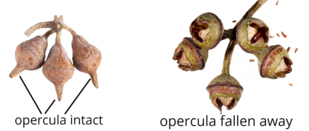 or a dorsaldorsal:
or a dorsaldorsal:
abaxial; the back of an organ; the side away from the axis (compare ventral)
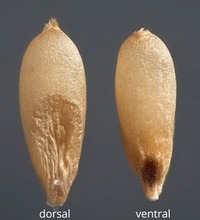 , laterallateral:
, laterallateral:
(of embryo) embryo lies along the side of the seed, generally towards one end; of, at, or from the side; in grasses, can refer to the sides adjacent to the dorsal and ventral sides
, or terminal, cap-like callosity is present and surrounded by micropylar collarmicropylar collar:
collar shaped tissue at micropyle
, except in Cartonema. Hils present, punctatepunctate:
surface relief - dotted with pits or with translucent, sunken glands or with colored dots, similar to pitted or larger and irregular, orbicularorbicular:
or larger and irregular, orbicularorbicular:
2D shape—circular in outline, 3D shape—globose
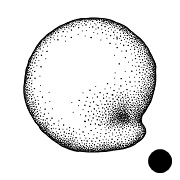 , or linearlinear:
, or linearlinear:
(shape) long, narrow, and uniform in width; (of embryo) embryo is straight and much longer than wide in shape. Hila may be dorsaldorsal:
in shape. Hila may be dorsaldorsal:
abaxial; the back of an organ; the side away from the axis (compare ventral)
 , laterallateral:
, laterallateral:
(of embryo) embryo lies along the side of the seed, generally towards one end; of, at, or from the side; in grasses, can refer to the sides adjacent to the dorsal and ventral sides
, semi-lateral, or terminal. Seed coat black, gray, blue, brown, or yellow, dulldull:
reflecting only a low proportion of incident light, with no apparent sheen , bonybony:
, bonybony:
very hard and rather brittle, like bone
, membranousmembranous:
texture—extremely thin, pliable, and fairly tough
or mealymealy:
loose, dry, and disintegrating in finely granular
pieces like meal or flour
in texture, always sculptured, and sometimes pubescent.
Embryo usually small but well developed, except Cartonema (embryo minute), basalbasal:
at or pertaining to the point of attachment; (of embryo) embryo occupies one end of the seed
, capitatecapitate:
head-shaped; abruptly enlarged on one end to a relatively short, terminal portion
to dumbbell shaped, straight.
Endosperm copious, mealy.
Noxious Weed: USA Federal Noxious Weed List, terrestrial, Commelina benghalensis L.
Federal Noxious Weed Disseminules of the US tool provides a description and image of this species. Aquarium & Pond Plants of the World tool includes descriptions and images of genera, which may be encountered.
Weedy along roadsides, railroads, streams and in fields and thickets. Thrives in wet or humid environments. Spreads by seed reproduction and stolon propagation.
| Fruit | |
| Type | loculicidalloculicidal: type of capsular dehiscence, opening longitudinally through the locules (compare septicidal)  capsulecapsule: capsulecapsule:a dry, dehiscent fruit derived from a compound ovary  , rarely a berryberry: , rarely a berryberry:an indehiscent, fleshy fruit with one or a few to many seeds. The flesh may be homogenous throughout. Or, if the outer part is hard, firm, or leathery, referred to as an hesperidium. Septa are present in some, and the seeds may be arillate or with a fleshy testa.  or berrylike capsulecapsule: or berrylike capsulecapsule:a dry, dehiscent fruit derived from a compound ovary  |
| Size range | 1.5–15 mm long |
| Shape(s) | globoseglobose: 3D shape—more or less spherical  , cylindricalcylindrical: , cylindricalcylindrical:3D shape—a cylinder, with parallel sides and a circular cross-section; tubular or rod-shaped , oblongoblong: 2D shape—much longer than broad with nearly parallel sides, corners are rounded  , ellipsoidellipsoid: , ellipsoidellipsoid:3D shape—elliptic , ovoidovoid: 3D shape—ovate  , trigonoustrigonous: , trigonoustrigonous:3D shape—having three faces that meet at distinct angles; triangular in outline |
| Texture | crustaceouscrustaceous: texture—thin, dry, indurate, and brittle , leatheryleathery: texture—moderately thick, tough, and very pliable , membranousmembranous: texture—extremely thin, pliable, and fairly tough |
| Surface relief | smooth or spinyspiny: having slender, stiff, sharp projections oriented in the general plane of the structure  , wartywarty: , wartywarty:surface relief—distinct, rounded projections that are large relative to the fruit size; tuberculate, verrucose  , reticulatereticulate: , reticulatereticulate:surface relief—netted, raised walls or concave grooves forming a net-like surface pattern with flat, concave, or convex interspaces  , wrinkledwrinkled: , wrinkledwrinkled:surface relief—shallow, irregular folds and furrows covering the surface; appearing overall though crumpled and then spread out  |
| Color(s) | brown, gray, black, white, blue |
| Seed | |
| Size range | 0.5–6 mm long |
| Shape(s) | hemisphericalhemispherical: 2D shape—shaped like half a sphere , globoseglobose: 3D shape—more or less spherical  , ovoidovoid: , ovoidovoid:3D shape—ovate  , squaresquare: , squaresquare:2D shape—geometric figure bounded by 4 straight sides of equal length and 4 90º-angles , cylindricalcylindrical: 3D shape—a cylinder, with parallel sides and a circular cross-section; tubular or rod-shaped , polygonalpolygonal: angular , reniformreniform: 2D or 3D shape—kidney-shaped  |
| Surface relief | reticulatereticulate: surface relief—netted, raised walls or concave grooves forming a net-like surface pattern with flat, concave, or convex interspaces  , ribbedribbed: , ribbedribbed:surface relief—wide, prominent, linear ridges that are generally rounded and longitudinally situated on the surface  , wrinkledwrinkled: , wrinkledwrinkled:surface relief—shallow, irregular folds and furrows covering the surface; appearing overall though crumpled and then spread out  , sculptured, alveolatealveolate: , sculptured, alveolatealveolate:surface relief—reticulated, honeycombed; ridges that intersect to form polygonal cells with a regular size and shape similar to a honeycomb  , pittedpitted: , pittedpitted:surface relief—surface with small depressions in which the areas between the hollows do not take on the appearance of a true reticular net  , groovedgrooved: , groovedgrooved:surface relief—linear depressions that may be single or form a series of grooves over the surface 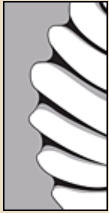 , striatestriate: , striatestriate:surface relief—having fine, parallel lines, grooves or ridges  , wartywarty: , wartywarty:surface relief—distinct, rounded projections that are large relative to the fruit size; tuberculate, verrucose  , pittedpitted: , pittedpitted:surface relief—surface with small depressions in which the areas between the hollows do not take on the appearance of a true reticular net  , punctatepunctate: , punctatepunctate:surface relief—dotted with pits or with translucent, sunken glands or with colored dots, similar to pitted  , granulargranular: , granulargranular:surface relief—having a grainy surface 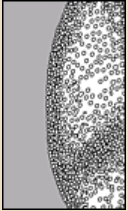 |
| Color(s) | black, gray, blue, brown, yellow |
| Other | |
| Embryo | usually small but well developed, except Cartonema (miniature embryo), basalbasal: at or pertaining to the point of attachment; (of embryo) embryo occupies one end of the seed , capitatecapitate: head-shaped; abruptly enlarged on one end to a relatively short, terminal portion to dumbbell shaped, straight |
| Nutritive tissue | endosperm copious and mealymealy: loose, dry, and disintegrating in finely granular pieces like meal or flour |
Pantropical, some temperate regions of Asia, Australia, and North America.
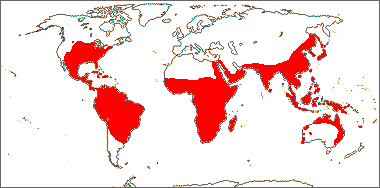
Distribution map courtesy of Angiosperm Phylogeny Website.
Baskin and Baskin 2021Baskin and Baskin 2021:
Baskin C and Baskin J. 2021. Relationship of the lateral embryo (in grasses) to other monocot embryos: A status up-grade. Seed Science Research 31 (3): 199-210. doi:10.1017/S0960258521000209; Dahlgren et al. 1985Dahlgren et al. 1985:
Dahlgren RMT, Clifford HT, and Yeo PF. 1985. The families of the monocotyledons: structure, evolution, and taxonomy. Springer-Verlag, Berlin. 520 pp.; Davidse et al. 2009–2018Davidse et al. 2009–2018:
Davidse GM, Sousa Sánchez M, Knapp S. and Chiang Cabrera F, eds. 2009–2018. Flora Mesoamericana. Missouri Botanical Garden, St. Louis, MO. Accessed: January–April 2024. URL: http://legacy.tropicos.org/Project/FM; Flora of North America Editorial Committee 1993+Flora of North America Editorial Committee 1993+:
Flora of North America Editorial Committee, eds. 1993+. Flora of North America North of Mexico [Online]. 22+ vols. Flora of North America Association, New York and Oxford. Accessed January-March 2024. URL: http://beta.floranorthamerica.org.; Kirkbride et al. 2006Kirkbride et al. 2006:
Kirkbride JH, Jr, Gunn CR, and Dallwitz MJ. 2006. Family guide for fruits and seeds, vers. 1.0. Accessed September 2020-January 2022. URL: https://nt.ars-grin.gov/seedsfruits/keys/frsdfam/index.cfm .; Kubitzki et al. 1990+Kubitzki et al. 1990+:
Kubitzki K et al., eds. 1990+. The families and genera of vascular plants. 7+ vols. Berlin etc.; Obermeyer and Faden 1985Obermeyer and Faden 1985:
Obermeyer AA and Faden RB. 1985. Commelinaceae. In: Leistner OA, ed. Flora of Southern Africa. Vol 4. Botanical Research Institute, Department of Agriculture and Water Supply, Pretoria.; Stevenson and Loconte 1995Stevenson and Loconte 1995:
Stevenson DW and Loconte H. 1995. A cladistic analysis of monocot families. In: Rudall PJ, Cribb PJ, Cutler DF, and Humphries CJ, eds. Monocotyledons: Systematics and Evolution. Royal Botanic Gardens, Kew.; Thiele and Adams 2014Thiele and Adams 2014:
Thiele KR and Adams LG. 2014. Families of Flowering Plants of Australia. Accessed January-December 2021. URL: https://keys.lucidcentral.org/keys/v3/FFPA/key/FFPA/Media/Html/index.htm; Zhengyi et al. 2004+Zhengyi et al. 2004+:
Zhengyi W, Raven PH, and Deyuan H. 2004+. Flora of China [online]. 25 vols. Science Press, Beijing China & Missouri Botanical Garden, St. Louis USA. Accessed January–March 2024. http://flora.huh.harvard.edu/china/
*The number of genera and species is based on Christenhusz and Byng 2016Christenhusz and Byng 2016:
Christenhusz MJM and Byng JW. 2016. The number of known plant species in the world and its annual increase. Phytotaxa 261 (3): 201-217. https://doi.org/10.11646/phytotaxa.261.3.1, which may differ from the number of genera in GRIN-Global.